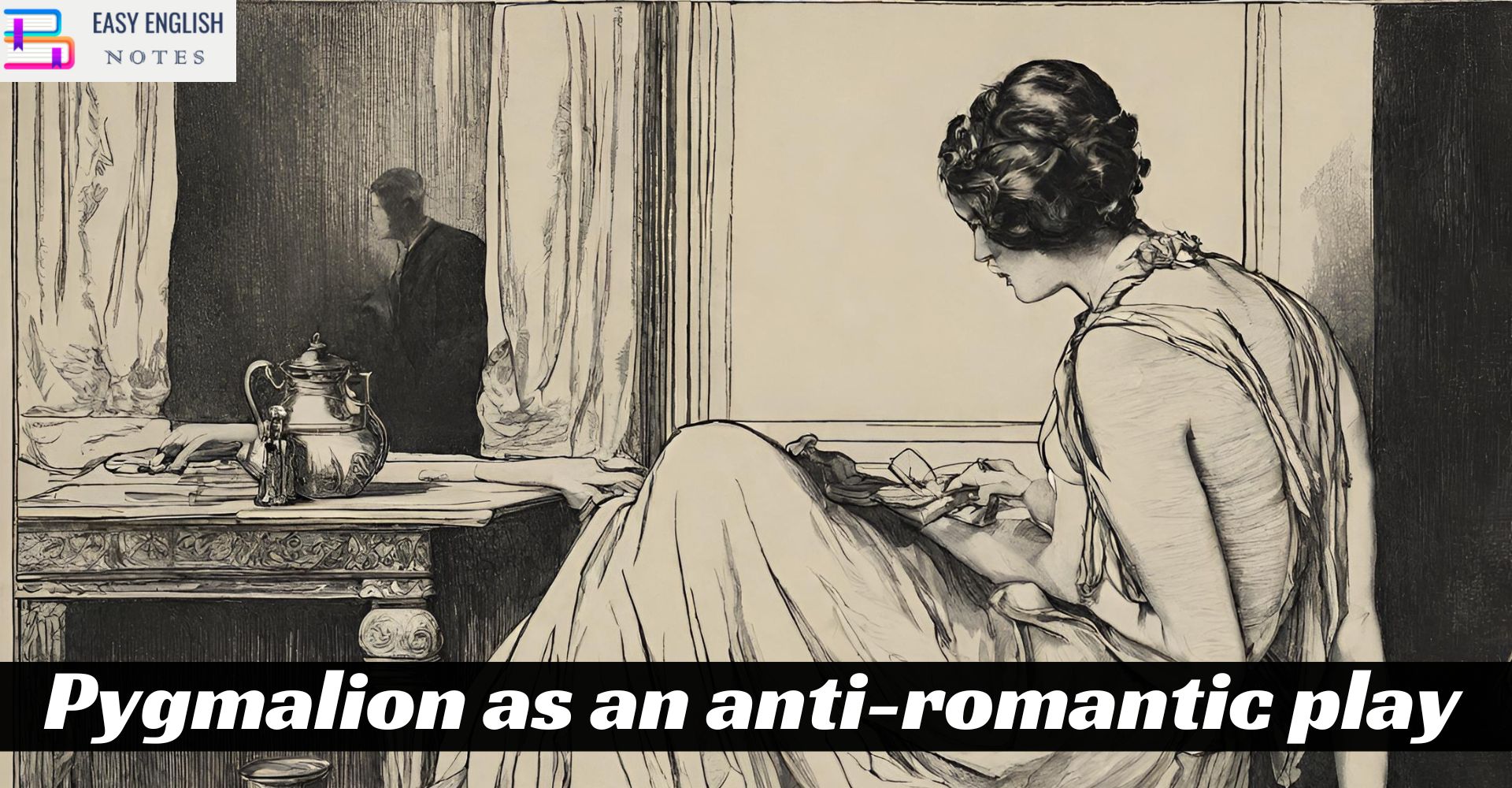“Pygmalion,” a play by George Bernard Shaw, is often regarded as an anti-romantic play, primarily because it subverts and challenges the conventional expectations of a romantic narrative. Here are several aspects that contribute to its anti-romantic character:
Absence of a Conventional Love Story:
Traditionally, romantic plays end with a resolution that involves the union of the main characters in love or marriage. In “Pygmalion,” while there’s an evolving relationship between Professor Henry Higgins and Eliza Doolittle, Shaw deliberately avoids turning it into a conventional romantic liaison. The play ends without a clear romantic resolution, defying the expected romantic narrative.
Focus on Individual Transformation Over Romance:
The primary focus of “Pygmalion” is on the transformation of Eliza Doolittle from a flower girl to a lady of society, through the tutelage of Henry Higgins. While this transformation could easily lend itself to a romantic storyline, Shaw emphasizes personal growth and social commentary over romantic development.
Critique of Class and Social Norms:
Shaw uses the play to critique the rigid class system and social norms of the time. Instead of romanticizing the relationship between Eliza and Higgins, he uses it to explore themes of power dynamics, class struggle, and the illusion of social mobility. This focus on social critique over romantic development further categorizes the play as anti-romantic.
Challenging the Pygmalion Myth:
The play is a reimagining of the Pygmalion myth from Ovid’s “Metamorphoses,” where a sculptor falls in love with a statue he created. Shaw’s version challenges this myth by refusing to culminate in a romantic union, thus subverting the original story’s romantic elements.
Realism and Practicality:
Shaw’s style is marked by realism and a focus on practical and intellectual concerns over emotional or romantic ones. The interactions between Higgins and Eliza are more intellectual and confrontational than romantic, emphasizing a pragmatic rather than an emotional connection.
Shaw’s Intention:
Shaw himself was opposed to the interpretation of “Pygmalion” as a romantic play. He emphasized in various writings and epilogues that the relationship between Higgins and Eliza was not romantic, criticizing adaptations that suggested a romantic ending.
Also Read :
- Compare Hamlet with Macbeth, Othello and other Tragedies
- “The Pardoner’s Tale” is the finest tale of Chaucer
- Prologue to Canterbury Tales – (Short Ques & Ans)
- Confessional Poetry – Definition & meaning
- Line By Line Explanation Of The Poem The Eve of St. Agnes
Labeling George Bernard Shaw’s “Pygmalion” as an anti-romantic play is a perspective that sheds light on Shaw’s departure from the conventional romantic narratives prevalent in his time. While the play features elements that could lead to a romantic storyline, Shaw deliberately steers away from these, focusing instead on themes of self-discovery, social class dynamics, and the power of language.
In traditional romantic narratives, the story often culminates in a romantic union or realization of love between the main characters. “Pygmalion,” however, subverts this expectation. The relationship between Professor Henry Higgins and Eliza Doolittle, despite undergoing significant developments and intense interactions, does not evolve into a conventional romantic liaison. Shaw intentionally avoids turning their relationship into a predictable love story. Instead, he emphasizes the personal growth and independence of Eliza, his protagonist.
The play’s conclusion is particularly telling in this regard. Contrary to typical romantic stories where the female lead might end up romantically involved with her male counterpart, Eliza asserts her independence from Higgins. This independence is not just about her ability to speak articulately but also reflects her newfound self-respect and desire for autonomy. The play ends with a sense of ambiguity regarding their relationship, further emphasizing its anti-romantic stance.
Moreover, Shaw’s focus on the transformative power of language and social critique overshadows any potential romantic plot. The play is more concerned with exploring societal norms, class divisions, and the power dynamics inherent in the act of transforming someone. The romantic elements, if any, are secondary to these broader themes.
In essence, “Pygmalion” stands as an anti-romantic play due to its deliberate avoidance of a traditional romantic plot, its focus on social critique and individual transformation, and its subversion of the typical romantic elements expected in such narratives. Shaw’s emphasis on intellectual and societal themes over romantic ones further solidifies the play’s position as a critique of romanticism.











